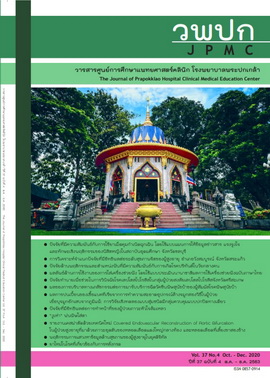Outcomes of Hearing Aid Use by International Outcome Inventory for Hearing Aids, Thai Version
Main Article Content
Abstract
Background: Hearing loss can occur in people of any age and is a major problem since patients with hearing loss have communication difficulty. Aural rehabilitation with a hearing aid can enhance their communication skills and improve their quality of life. Evaluation of hearing aid use outcomes can help to improve the patient care for healthcare providers.
Objectives: To investigate the outcomes of hearing aid use in hearing impaired patients by adopting the Thai version of International Outcome Inventory for Hearing Aids (IOI-HA) and factors affecting the outcomes.
Materials and methods: This is a cross-sectional study of the subjects who have been fitted with hearing aids at the Department of Otolaryngology, Burapha University Hospital from August 2018 to May 2019. The International Outcome Inventory for Hearing Aids (IOI-HA), Thai version was completed by face-to-face or telephone interview. The data were analyzed using descriptive statistics and logistic regression.
Results: A total of 158 patients (80 males and 78 females with an average age of 71.4 years) were enrolled. It was revealed that 57.6% of participants were very satisfied with the hearing aids, 38.0% were generally satisfied, whereas 4.4% were dissatisfied. The total IOI-HA scores were significantly correlated with average hearing threshold level (pure-tone average; PTA), speech discrimination score (SDS) and custom-made typed hearing aids. However, 58.2% of the subjects reported that the hearing aids had slightly to moderately helped, and only 37.0% used the hearing aids for more than 8 hours a day.
Conclusion: Therefore, longer daily use should be encouraged and custom-made hearing aids are recommended. Meanwhile the patients’ hearing level should be taken into account in order to enhance the hearing aid users’ satisfaction.
Article Details
References
World Health Organization. Deafness and hearing loss [Internet]. 2019 [cited 2019 Mar 1]. Available from: https://www.who.int/news-room/fact-sheets/detail/deafness-and-hearing-loss
World Health Organization. Deafness prevention [Internet]. 2018 [cited 2019 Mar 1]. Available form: https://www.who.int/deafness/estimates/en/
Ministry of Social Development and Human Security, Department of Empowerment of Persons with Disabilities. Report of the situation of the disabled in Thailand [Internet]. 2018 [cited 2019 Mar 1]. Available form: https://nadt.or.th/pages/stat61.html
Davis A, Smith P, Ferguson M, Stephens D, Gianopoulos I. Acceptability, benefit and costs of early screening for hearing disability: a study of potential screening tests and models. Health Technol Assess 2007;11(42):1-294.
Ferguson MA, Kitterick PT, Chong LY, Edmondson-Jones M, Barker F, Hoare DJ. Hearing aids for mild to moderate hearing loss in adults [Internet]. 2017 [cited 2019 Mar 1]. Available form: https://www.cochrane.org/CD012023/ENT_hearing-aids-mild-moderate-hearing-loss-adults
Stach BA, Ramachandran V. Hearing aids: strategies of amplification. In: Flint PW, Haughey BH, Lund VJ, Niparko JK, Richardson MA, Bobbins KT, et al, editors. Cumming otolaryngology-head and neck surgery. 5thed. Philadelphia: Mosby Elsevier; 2010. p. 2265-75.
National Health Security Office. Principle, method and expense of aural rehabilitation service and hearing aid devices for hearing impaired persons in national health security system [Internet]. 2015 [cited 2018 May 1]. Available form: https://www.nhso.go.th/files/userfiles/file/ฟื้นฟู/ประกาศฯการปรับปรุงบัญชีรายการอุปกรณ์เครื่องช่วยปีงบประมาณ2559(1).pdf
Wu X, Ren Y, Wang Q, Li B, Wu H, Huang Z, et al. Factors associated with the efficiency of hearing aids for patients with age-related hearing loss. Clin Interv Aging 2019;14:485-92.
Yimtae K, Thanawirattananit P, Kasemsiri P, Siriphaopradit P, Vatanasapt P, Laohasiriwong S, et al. Effectiveness of NECTEC model, body-worn, digital hearing aids and cost of screening and hearing aids service in elders [Internet]. 2014 [cited 2018 May 1]. Available from: http://164.115.27.97/digital/items/show/8657
Kozlowski L, Almeida G, Ribas A. Level of user satisfaction with hearing aids and environment: the international outcome inventory for hearing aids. Int Arch Otorhinolaryngol 2014;18:229-34.
Liu H, Zhang H, Liu S, Chen X, Han D, Zhang L. International outcome inventory for hearing aids (IOI-HA): results from the Chinese version. Int J Audiol 2011;50:673-8.
Ulusoy S, Muluk NB, San T, Cingi C. Evaluation of patient satisfaction with different hearing aids: A study of 107 patients. Ear Nose Throat J 2017;96(1):E22-8.
Arlinger S, Nordqvist P, Öberg M. International outcome inventory for hearing aids: data from a large Swedish quality register database. Am J Audiol 2017;26(3S):443-50.
Brännström KJ, Wennerström I. Hearing aid fitting outcome: clinical application and psychometric properties of a Swedish translation of the international outcome inventory for hearing aids (IOI-HA). J Am Acad Audiol 2010;21:512-21.
Brännström KJ, Lantz J, Nielsen LH, Olsen SØ. Prediction of IOI-HA scores using speech reception thresholds and speech discrimination scores in quiet. J Am Acad Audiol 2014; 25:154-63.
Chang YS, Choi J, Moon IJ, Hong SH, Chung WH, Cho YS. Factors associated with self- reported outcome in adaptation of hearing aid. Acta Otolaryngol 2016;136:905-11.
Inoue DP, Bogaz EA, Barros F, Penido NO. Comparison of hearing recovery criteria in sudden sensorineural hearing loss. Braz J Otorhinolaryngol 2012;78(3):42-8.
Solheim J. Preconceptions and expectations of older adults about getting hearing aids. J Multidiscip Healthc 2011;4:1-8.
Jespersen CT, Bille M, Legarth JV. Psychometric properties of a revised Danish translation of the international outcome inventory for hearing aids (IOI-HA). Int J Audiol 2014;53:302-8.
Aurélio FS, Silva SP, Rodrigues LB, Kuniyoshi IC, Botelho MS. Satisfaction of patients fit with a hearing aid in a high complexity clinic. Braz J Otorhinolaryngol 2012;78(5):69-77.

